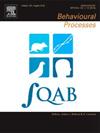Good sperm producers are more likely to participate in incubation in the Asian barn swallow Hirundo rustica gutturalis
IF 1.3
4区 生物学
Q4 BEHAVIORAL SCIENCES
引用次数: 0
Abstract
Sperm competition favors increased investment in post-copulatory sexual traits (e.g., long sperm) while reducing parental investment. The relationship between the two investments, however, remains unclear, although it affects the direction and speed of the evolution of each trait. Here, using the Asian barn swallow Hirundo rustica gutturalis, we examined the relationship between total sperm length (i.e., a post-copulatory sexual trait in birds) and male incubation participation (i.e., a paternal investment). This study system provides a unique opportunity to test the relationship, because male incubation has evolved as a derived trait and has not yet been fixed in the populations. After controlling for potential confounding factors (i.e., body condition and pre-copulatory sexual traits), we found that the probability of male participation in incubation increased with the total sperm length. Given that long sperm would secure within-pair paternity, incubation investment by males with long sperm would be adaptive in these sparse populations, rather than pursuing unlikely opportunities for extrapair mating at the expense of participation in incubation. The observed pattern was contrary to the negatively correlated evolution between the total sperm size and male participation in incubation in the family Hirundinidae, indicating that the direction of the relationship between post-copulatory sexual traits and paternal investment can be different from the general pattern of the clade depending on the ecological and evolutionary settings.
好的精子生产者更有可能参与亚洲仓燕的孵化
精子竞争有利于增加交配后性特征(如长精子)的投资,同时减少亲代投资。然而,这两种投资之间的关系仍不清楚,尽管它影响着每种特征进化的方向和速度。本研究以亚洲小燕子Hirundo rustica gutturalis为研究对象,研究了精子总长度(即鸟类交配后的性特征)与雄性孵育参与(即父系投入)之间的关系。这一研究系统为测试这种关系提供了一个独特的机会,因为雄性孵化是作为一种衍生特征进化而来的,在种群中尚未固定。在控制了潜在的混杂因素(即身体状况和交配前的性特征)后,我们发现男性参与孵育的概率随着精子总长度的增加而增加。考虑到长精子可以确保对内父系关系,长精子的雄性在这些稀疏的种群中进行孵化投资将是适应性的,而不是以牺牲参与孵化为代价,追求不太可能的对外交配机会。这一模式与毛蛛科总精子大小与雄性参与孵化的负相关进化相反,表明交配后性性状与父本投入的关系方向可能与该支系的一般模式不同,取决于生态和进化环境。
本文章由计算机程序翻译,如有差异,请以英文原文为准。
求助全文
约1分钟内获得全文
求助全文
来源期刊

Behavioural Processes
生物-动物学
CiteScore
2.70
自引率
7.70%
发文量
144
审稿时长
4-8 weeks
期刊介绍:
Behavioural Processes is dedicated to the publication of high-quality original research on animal behaviour from any theoretical perspective. It welcomes contributions that consider animal behaviour from behavioural analytic, cognitive, ethological, ecological and evolutionary points of view. This list is not intended to be exhaustive, and papers that integrate theory and methodology across disciplines are particularly welcome.
 求助内容:
求助内容: 应助结果提醒方式:
应助结果提醒方式:


